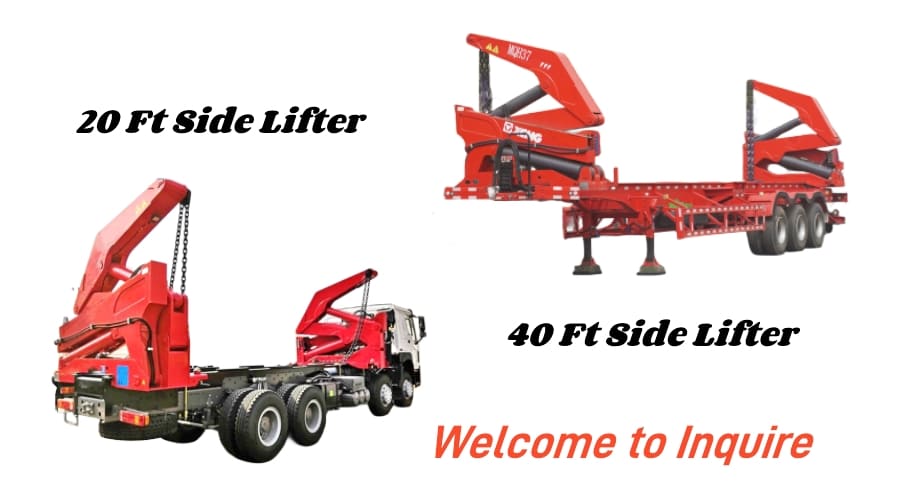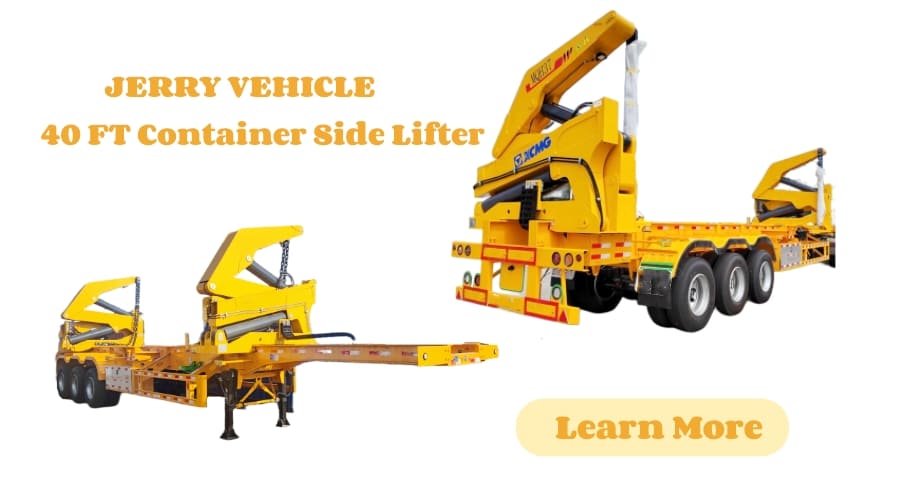Development History of Side Lifter Trailer
The container self-loading and unloading transport truck, that is, the side lifter trailer, is towed by a tractor. The front and rear are equipped with booms that are similar to the truck-mounted crane. Their function is to lift the container as a whole for loading and unloading.
1. Side lifter trailer are mainly divided into vehicle-mounted type (20 feet), which can be customized for loading and unloading on the left or right side according to adapting habits and usage scenarios. Trailers (40 feet, 20 feet) can be loaded and unloaded on the left or right side according to adapting habits and usage scenarios.
2. Development history of side lifter trailer
The world's first side-loading integrated transport vehicle with container handling and transportation functions was produced by Hammer in 1988. Since then, with the development of truck-mounted container transportation, its types and quantities have continued to increase, and its application scope has become wider and wider. Before the emergence of this model, container loading and unloading operations could only be completed by large forklifts, container straddle carriers and other equipment. However, this operation mode has great limitations: it has high requirements on the working site. Container straddle carriers are mainly used for port loading and unloading, and forklifts The operating site requires special treatment to improve its strength and smoothness; it needs to be equipped with corresponding container transport vehicles, and the number of operating links and equipment types increases, resulting in low support efficiency and high costs.
3. Application
Side lifter trailer are widely used in the connection of railways, waterways, and empty container transportation. In addition to the basic purpose of loading and unloading containers, pallets can also be used to load, unload and carry various equipment and equipment, perform container palletizing operations, and cooperate with railway flat cars for container delivery. Side crane transport trucks can serve as links between ports, train stations, airports and other areas.

3. Application
Side lifter trailer are widely used in the connection of railways, waterways, and empty container transportation. In addition to the basic purpose of loading and unloading containers, pallets can also be used to load, unload and carry various equipment and equipment, perform container palletizing operations, and cooperate with railway flat cars for container delivery. Side crane transport trucks can serve as links between ports, train stations, airports and other areas.
4.Mainstream manufacturers
The main companies that produce and sell side lifter trailer in the world are Hammer of Sweden, Steelbro and Swingthru of New Zealand, and Klaus of Germany.
4.1 Swedish Hammer Company
Swedish Hammer Company specializes in the development, production and sales of container self-loading and unloading transportation equipment. The main product series are: 150 series, 160 series and 190 series, of which 180 series is only suitable for 20-foot containers. The company's products have a variety of operating functions such as palletizing, vehicle-to-vehicle loading and unloading, and self-loading and unloading.
4.2 New Zealand Steelbro Company
Steelbro's 40-foot container carriers are widely used in military and commercial applications around the world. The company mainly includes two series, SB and SE, with a total of nine models. The company's products have a loading and unloading capacity ranging from 33 to 48 tons. All models can load, unload or transport one 40-foot or two 20-foot containers. The power unit is a Kubota 42 diesel engine. 4.3 New Zealand Swngthru Company
The company is famous for its production of double-side loading and unloading container dump trucks. Its products mainly include four tonnage classes: 10T, 20T, 27T and 35T, and are suitable for a wide range of containers. The company's patented structure is a swing-arm self-loading and unloading mechanism, which has the advantages of simple structure and high reliability.
4.4 German Klaus Company
The company is committed to providing side-mounted container self-loading and unloading transportation equipment to the military around the world. Its main products include KM32, KM26 and KM20 series.

6. Development characteristics and trends
1. Product serialization: With the rapid development of container transportation, the number is increasing and the scope of application is becoming wider and wider. In order to adapt to different environments in different regions and the needs of different users, major companies have successively developed series of products.
2. Lightweight structure: Choose high-light materials, optimize structural parts to increase stress and load-bearing capacity, and reduce the size of structural parts as much as possible without affecting performance. Lightweighting will help increase vehicle load and improve vehicle fuel economy.
3. Diversified functions: Each company's products basically have their own unique functions, such as extended spreaders, automatic twist locks, container locking chains, etc. As competition intensifies and user demands escalate, companies will be more stimulated to improve their product functional advantages.
4. Vehicle automation: Reducing costs, reducing on-board personnel and improving work safety are inevitable requirements for the development of logistics and transportation. Remote control realizes remote control, saves timower, and avoids blind spots; the swing arm and telescopic arm of the air conditioning mechanism adopt hydraulic synchronous or asynchronous control to ensure the stability of the lifting process; the electronic control system of the lifting mechanism, the programmable controller controls the lifting The mechanism and hydraulic outriggers adopt an interlocking design to reduce operating errors; in terms of anti-overloading, the hydraulic outriggers are equipped with pressure sensors that can alert when the system load reaches a critical value to prevent rollover events during the lifting process.